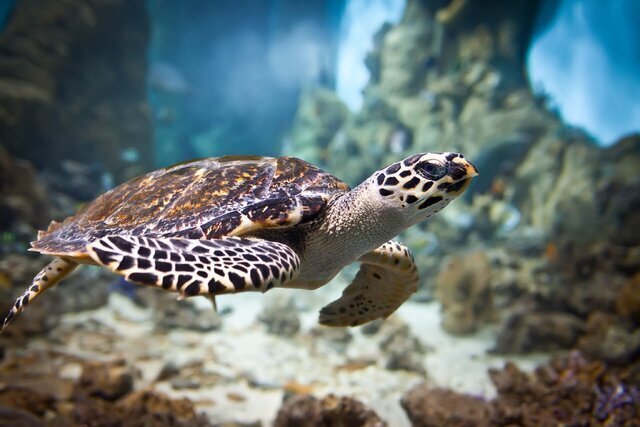DOE adopts measures to preserve marine ecosystems

TEHRAN –The Department of Environment (DOE) has implemented different measures to conserve the biodiversity of the marine ecosystems in the country.
The measures include developing a biodiversity database, protecting endangered species, and registering islands, an official with DOE has said.
"The rationale behind developing a biodiversity database - which will be publicly accessible - is to create a regional reference for all coastal states and scientifically classify data and information about indigenous, non-indigenous, and invasive species in the Persian Gulf, the Oman Sea, and the Caspian Sea’s ecosystems," ISNA quoted Mohammad Talebi-Matin as saying.
He made the remarks on the occasion of Persian Gulf National Day which is observed on April 29 every year. The day marks the anniversary of forcing out the Portuguese navy of the Strait of Hormuz in the Capture of Ormuz (1622).
“All available information about the plant and animal species of these three ecosystems have been collected for inclusion in the database,” he added.
Currently, the country's marine biodiversity database is going through the programming phase.
Once unveiled, the biodiversity information of other seas of the country is supposed to be included in this database with continuous updates, the official further noted.
The DOE plans to protect the Persian Gulf endangered species particularly the critically endangered species such as turtles.
This year, as in the past, the DOE with the help of coastal administrations, industries, and universities will monitor the turtles’ habitats, tag breeding turtles, and establish hatchery sites where needed.
Talebi-Matin went on to say that currently, five important islands in the Persian Gulf have been registered. All their coastal areas have been categorized and classified in terms of biology and habitat features up to a depth of six meters or more.
But certain islands, particularly military ones, require special permits to be registered, he noted.
Some other islands due to being far from the coast cannot be equipped with all the equipment or supported by the research group.
Despite the environmental preservation responsibilities of industries and organizations, some fail to provide the necessary cooperation, the official said.
Climate change, pollution threat Persian Gulf coral reefs
The Persian Gulf’s unique marine habitat is home to about eight percent of the world's coral reefs with more than 50 species, however, climate change, global warming, and pollution are pushing them toward extinction.
Coral reefs are in danger of disappearing mainly due to oil pollution, with the fourth coral bleaching event currently underway, IRNA quoted Talebi-Matin, as saying.
The Persian Gulf has an area of about 241,000 square kilometers. Its length is some 990 km, and its width varies from a maximum of about 340 km to a minimum of 55 km in the Strait of Hormuz.
It has its own environmental characteristics, as it is a semi-closed sea, aging 15,000 years, with an average depth of 35 meters, while being highly salty with severe heat fluctuations, and an annual evaporation rate of 140 cm.
The diverse marine life in the Persian Gulf includes more than 1,600 species of fish (about 500 species in the Persian Gulf and 1,142 species in the Sea of Oman).
Moreover, there are 15 species of shrimp, 10 species of marine mammals, five species of sea turtles, more than 90 species of birds, and a wide variety of plankton.
This rich biodiversity stresses the importance of conserving the marine ecosystems in the Persian Gulf, the official added.
He went on to say that a total of 111 coral species have been identified in the Persian Gulf, with 103 species found in the Iranian islands of the region which further highlights the significance of protecting coral reefs for the overall health of the ecosystem.
In recent years, coral reefs have suffered bleaching due to exposure to pollution and global warming, putting them at risk of completely disappearing if necessary measures are not taken.
The marine ecosystems in the Persian Gulf have been significantly impacted by environmental pollution, including industrial waste, oil spills, chemical effluents, and marine debris. These factors, combined with climate change effects like rising temperatures and seawater acidification, have led to severe damage to the marine habitats in the region.
The deterioration of coral reefs poses a significant challenge as they play a crucial role in maintaining ecological balance in the seas. Human activities such as coastal development, dredging, overfishing, and exploitation of marine resources, along with climate change impacts, have resulted in the destruction and loss of coral reefs and reduced biodiversity in the Persian Gulf.
Over a span of 22 years, various human activities like land reclamation, discharge of urban and industrial wastewater, port construction, vessel traffic, fishing, road building, population growth, and tourism have contributed to the degradation of marine ecosystems in the region.
Efforts to protect the valuable marine ecosystem include updating the list of endangered marine species, expanding restoration efforts for wetland habitats and coral reefs, and implementing conservation measures in a wider area to safeguard these vulnerable ecosystems.
MT/MG
Leave a Comment